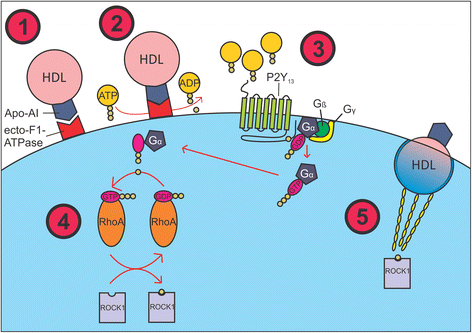The potential role of mitochondrial ATP synthase inhibitory factor 1 (IF1) in coronary heart disease: a literature review
- PMID: 28173810
- PMCID: PMC5297070
- DOI: 10.1186/s12944-017-0430-9
The potential role of mitochondrial ATP synthase inhibitory factor 1 (IF1) in coronary heart disease: a literature review
Abstract
Cardiovascular disease (CVD) is the leading cause of death worldwide, and so the search for innovative and accurate biomarkers for guiding prevention, diagnosis, and treatment is a valuable clinical and economic endeavor. Due to a recent findings that the serum concentration of mitochondrial ATP synthase inhibitory factor 1 (IF1) is an independent prognostic factor in patients with coronary heart disease (CHD), we reviewed the role of this protein in myocardial ischemic preconditioning, its correlation to plasma high density lipoprotein (HDL), the predictive potential in patients with CHD, and its interplay with angiogenesis. IF1 has been positively correlated with plasma HDL-cholesterol, and is independently negatively associated with all-cause and CV mortality in patients with CHD. However, this conclusion is prevalently based on limited data, and more research is needed to draw definitive conclusions. IF1 seems to play an additional role in increasing cell vulnerability in oncologic diseases but may also function as modest inhibitor of angiogenesis in physiological conditions. It has been also explored that IF1 may rather act as a modulator of other molecules more significantly involved in angiogenesis, especially apolipoprotein A1 on which the largest effect could be observed. In conclusion, more research is needed to characterize the role of IF1 in patients with CHD.
Keywords: Angiogenesis; Cardiovascular disease; High density lipoprotein; Inhibitory factor 1.
Figures

Similar articles
-
Serum levels of mitochondrial inhibitory factor 1 are independently associated with long-term prognosis in coronary artery disease: the GENES Study.BMC Med. 2016 Aug 23;14(1):125. doi: 10.1186/s12916-016-0672-9. BMC Med. 2016. PMID: 27553421 Free PMC article.
-
Serum IF1 concentration is independently associated to HDL levels and to coronary heart disease: the GENES study.J Lipid Res. 2013 Sep;54(9):2550-8. doi: 10.1194/jlr.P036335. Epub 2013 Jun 21. J Lipid Res. 2013. PMID: 23794714 Free PMC article.
-
Mitochondrial inhibitory factor 1 (IF1) is present in human serum and is positively correlated with HDL-cholesterol.PLoS One. 2011;6(9):e23949. doi: 10.1371/journal.pone.0023949. Epub 2011 Sep 14. PLoS One. 2011. PMID: 21935367 Free PMC article.
-
Regulation of the H+-ATP synthase by IF1: a role in mitohormesis.Cell Mol Life Sci. 2017 Jun;74(12):2151-2166. doi: 10.1007/s00018-017-2462-8. Epub 2017 Feb 6. Cell Mol Life Sci. 2017. PMID: 28168445 Free PMC article. Review.
-
A Review of the Inhibition of the Mitochondrial ATP Synthase by IF1 in vivo: Reprogramming Energy Metabolism and Inducing Mitohormesis.Front Physiol. 2018 Sep 19;9:1322. doi: 10.3389/fphys.2018.01322. eCollection 2018. Front Physiol. 2018. PMID: 30283362 Free PMC article. Review.
Cited by
-
Neuroprotective Effect of a Novel ATP-Synthase Inhibitor Bedaquiline in Cerebral Ischemia-Reperfusion Injury.Int J Mol Sci. 2021 Sep 8;22(18):9717. doi: 10.3390/ijms22189717. Int J Mol Sci. 2021. PMID: 34575875 Free PMC article.
-
Pathogenesis of cardiovascular diseases: effects of mitochondrial CF6 on endothelial cell function.Mol Cell Biochem. 2025 Feb;480(2):841-853. doi: 10.1007/s11010-024-05065-2. Epub 2024 Jul 10. Mol Cell Biochem. 2025. PMID: 38985252 Review.
-
Quantitative proteomics reveals the regulatory networks of circular RNA BTBD7_hsa_circ_0000563 in human coronary artery.J Clin Lab Anal. 2020 Nov;34(11):e23495. doi: 10.1002/jcla.23495. Epub 2020 Jul 25. J Clin Lab Anal. 2020. PMID: 32710445 Free PMC article.
-
The Effect of Chinese Medicine on Lipid and Glucose Metabolism in Acute Myocardial Infarction Through PPARγ Pathway.Front Pharmacol. 2018 Oct 24;9:1209. doi: 10.3389/fphar.2018.01209. eCollection 2018. Front Pharmacol. 2018. PMID: 30405421 Free PMC article.
-
Regulation of STAT3 and its role in cardioprotection by conditioning: focus on non-genomic roles targeting mitochondrial function.Basic Res Cardiol. 2021 Oct 12;116(1):56. doi: 10.1007/s00395-021-00898-0. Basic Res Cardiol. 2021. PMID: 34642818 Free PMC article. Review.
References
Publication types
MeSH terms
Substances
LinkOut - more resources
Full Text Sources
Other Literature Sources

